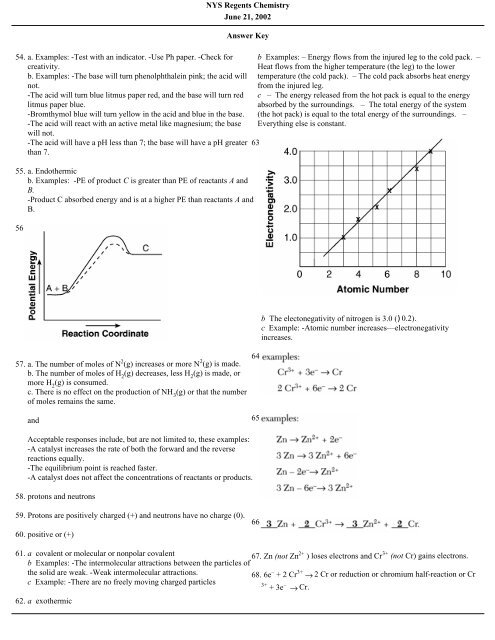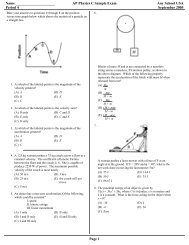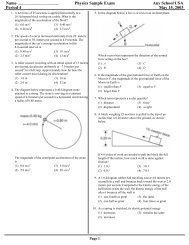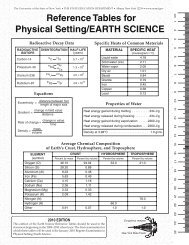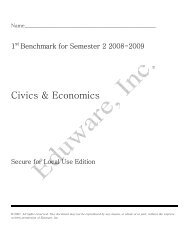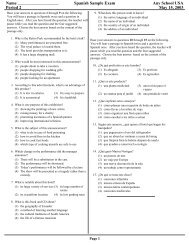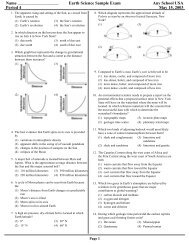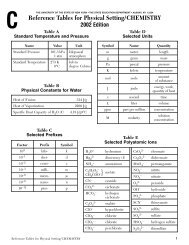NYS Regents Chemistry June 21, 2002 - Eduware
NYS Regents Chemistry June 21, 2002 - Eduware
NYS Regents Chemistry June 21, 2002 - Eduware
Create successful ePaper yourself
Turn your PDF publications into a flip-book with our unique Google optimized e-Paper software.
<strong>NYS</strong> <strong>Regents</strong> <strong>Chemistry</strong><br />
<strong>June</strong> <strong>21</strong>, <strong>2002</strong><br />
Answer Key<br />
54. a. Examples: -Test with an indicator. -Use Ph paper. -Check for<br />
creativity.<br />
b. Examples: -The base will turn phenolphthalein pink; the acid will<br />
not.<br />
-The acid will turn blue litmus paper red, and the base will turn red<br />
litmus paper blue.<br />
-Bromthymol blue will turn yellow in the acid and blue in the base.<br />
-The acid will react with an active metal like magnesium; the base<br />
will not.<br />
-The acid will have a pH less than 7; the base will have a pH greater<br />
than 7.<br />
55. a. Endothermic<br />
b. Examples: -PE of product C is greater than PE of reactants A and<br />
B.<br />
-Product C absorbed energy and is at a higher PE than reactants A and<br />
B.<br />
56.<br />
b Examples: – Energy flows from the injured leg to the cold pack. –<br />
Heat flows from the higher temperature (the leg) to the lower<br />
temperature (the cold pack). – The cold pack absorbs heat energy<br />
from the injured leg.<br />
c – The energy released from the hot pack is equal to the energy<br />
absorbed by the surroundings. – The total energy of the system<br />
(the hot pack) is equal to the total energy of the surroundings. –<br />
Everything else is constant.<br />
63.<br />
57. a. The number of moles of N 2 (g) increases or more N 2 (g) is made.<br />
b. The number of moles of H 2<br />
(g) decreases, less H 2<br />
(g) is made, or<br />
more H 2<br />
(g) is consumed.<br />
c. There is no effect on the production of NH 3<br />
(g) or that the number<br />
of moles remains the same.<br />
64.<br />
b The electonegativity of nitrogen is 3.0 ()0.2).<br />
c Example: -Atomic number increases—electronegativity<br />
increases.<br />
and<br />
65.<br />
Acceptable responses include, but are not limited to, these examples:<br />
-A catalyst increases the rate of both the forward and the reverse<br />
reactions equally.<br />
-The equilibrium point is reached faster.<br />
-A catalyst does not affect the concentrations of reactants or products.<br />
58. protons and neutrons<br />
59. Protons are positively charged (+) and neutrons have no charge (0).<br />
60. positive or (+)<br />
66.<br />
61. a covalent or molecular or nonpolar covalent<br />
b Examples: -The intermolecular attractions between the particles of<br />
the solid are weak. -Weak intermolecular attractions.<br />
c Example: -There are no freely moving charged particles<br />
62. a exothermic<br />
67. Zn (not Zn 2+ ) loses electrons and Cr 3+ (not Cr) gains electrons.<br />
68. 6e – + 2 Cr 3+ → 2 Cr or reduction or chromium half-reaction or Cr<br />
3+<br />
3+<br />
+ 3e – → Cr.


